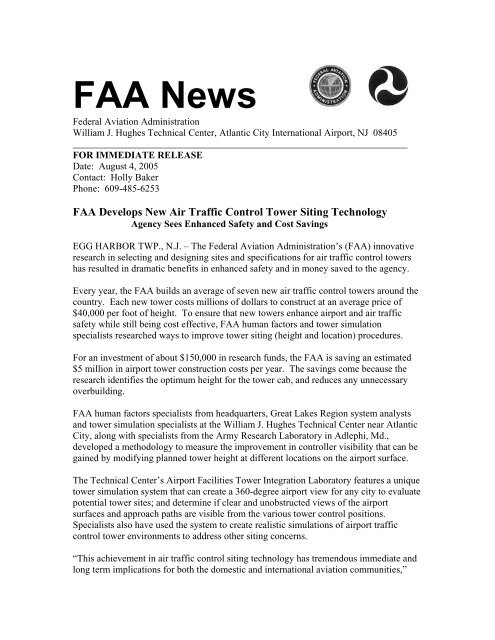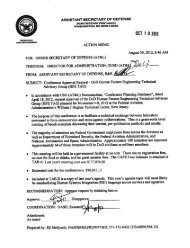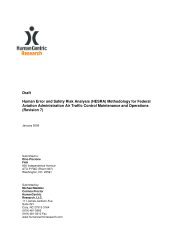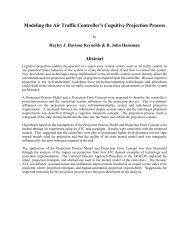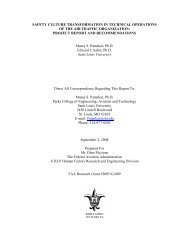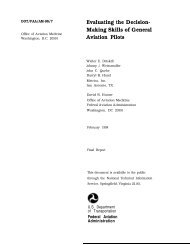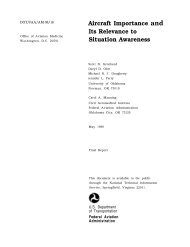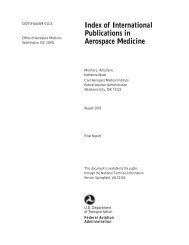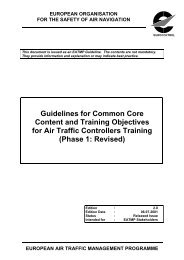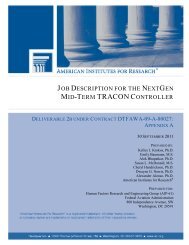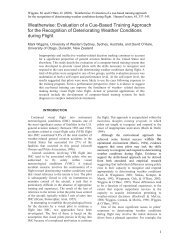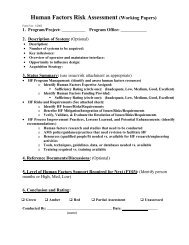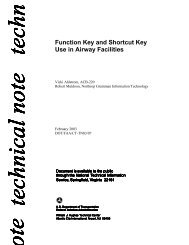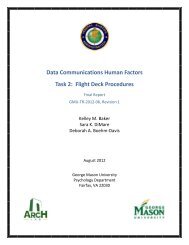FAA Develops New Air Traffic Control Tower Siting Technology
FAA Develops New Air Traffic Control Tower Siting Technology
FAA Develops New Air Traffic Control Tower Siting Technology
You also want an ePaper? Increase the reach of your titles
YUMPU automatically turns print PDFs into web optimized ePapers that Google loves.
<strong>FAA</strong> <strong>New</strong>sFederal Aviation AdministrationWilliam J. Hughes Technical Center, Atlantic City International <strong>Air</strong>port, NJ 08405_____________________________________________________________________FOR IMMEDIATE RELEASEDate: August 4, 2005Contact: Holly BakerPhone: 609-485-6253<strong>FAA</strong> <strong>Develops</strong> <strong>New</strong> <strong>Air</strong> <strong>Traffic</strong> <strong>Control</strong> <strong>Tower</strong> <strong>Siting</strong> <strong>Technology</strong>Agency Sees Enhanced Safety and Cost SavingsEGG HARBOR TWP., N.J. – The Federal Aviation Administration’s (<strong>FAA</strong>) innovativeresearch in selecting and designing sites and specifications for air traffic control towershas resulted in dramatic benefits in enhanced safety and in money saved to the agency.Every year, the <strong>FAA</strong> builds an average of seven new air traffic control towers around thecountry. Each new tower costs millions of dollars to construct at an average price of$40,000 per foot of height. To ensure that new towers enhance airport and air trafficsafety while still being cost effective, <strong>FAA</strong> human factors and tower simulationspecialists researched ways to improve tower siting (height and location) procedures.For an investment of about $150,000 in research funds, the <strong>FAA</strong> is saving an estimated$5 million in airport tower construction costs per year. The savings come because theresearch identifies the optimum height for the tower cab, and reduces any unnecessaryoverbuilding.<strong>FAA</strong> human factors specialists from headquarters, Great Lakes Region system analystsand tower simulation specialists at the William J. Hughes Technical Center near AtlanticCity, along with specialists from the Army Research Laboratory in Adlephi, Md.,developed a methodology to measure the improvement in controller visibility that can begained by modifying planned tower height at different locations on the airport surface.The Technical Center’s <strong>Air</strong>port Facilities <strong>Tower</strong> Integration Laboratory features a uniquetower simulation system that can create a 360-degree airport view for any city to evaluatepotential tower sites; and determine if clear and unobstructed views of the airportsurfaces and approach paths are visible from the various tower control positions.Specialists also have used the system to create realistic simulations of airport trafficcontrol tower environments to address other siting concerns.“This achievement in air traffic control siting technology has tremendous immediate andlong term implications for both the domestic and international aviation communities,”
said Charlie Keegan, Vice President for Operations Planning Services of the <strong>FAA</strong>’s <strong>Air</strong><strong>Traffic</strong> Organization. “It will enable tower planners to find and resolve potentialproblems before tower construction begins. The technology will enhance safety andefficiency, and will save the <strong>FAA</strong> millions of dollars in tower construction costs in yearsto come.”Previously, the tower siting process did not include human factors criteria. In the recentresearch, the <strong>FAA</strong> used air traffic controller visual perspective information, visualperformance capability information from the Department of Defense, as well as limitsimposed by terminal instrument procedures to determine appropriate airport trafficcontrol tower heights.As a result of the tests, researchers created a tool that uses two metrics specifyingminimum performance criteria for future tower location and height. In the past, the <strong>FAA</strong>often built towers at heights exceeding those required for visual discrimination, because,in part, no minimum performance requirements existed. Since these requirements areknown now, the agency will achieve cost savings as towers can be built at lower heights.In the past five years, technical center specialists have conducted tower siting simulationstudies for more than 50 airports, in the tower integration laboratory.###


